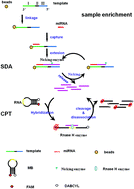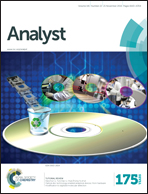Signal amplification of microRNAs with modified strand displacement-based cycling probe technology
Abstract
Micro ribose nucleic acids (miRNAs) play an important role in biological processes such as cell differentiation, proliferation and apoptosis. Therefore, miRNAs are potentially a powerful marker for monitoring cancer and diagnosis. Here, we present sensitive signal amplification for miRNAs based on modified cycling probe technology with strand displacement amplification. miRNA was captured by the template coupled with beads, and then the first cycle based on SDA was repeatedly extended to the nicking end, which was produced by the extension reaction of miRNA. The products generated by SDA are captured by a molecular beacon (MB), which is designed to initiate the second amplification cycle, with a similar principle to the cycling probe technology (CPT), which is based on repeated digestion of the DNA–RNA hybrid by the RNase H. After one sample enrichment and two steps of signal amplification, 0.1 pM of let-7a can be detected. The miRNA assay exhibits a great dynamic range of over 100 orders of magnitude and high specificity to clearly discriminate a single base difference in miRNA sequences. This isothermal amplification does not require any special temperature control instrument. The assay is also about signal amplification rather than template amplification, therefore minimising contamination issues. In addition, there is no need for the reverse transcription (RT) process. Thus the amplification is suitable for miRNA detection.

- This article is part of the themed collection: Celebrating 100 years of Chemistry at Nanjing University

 Please wait while we load your content...
Please wait while we load your content...